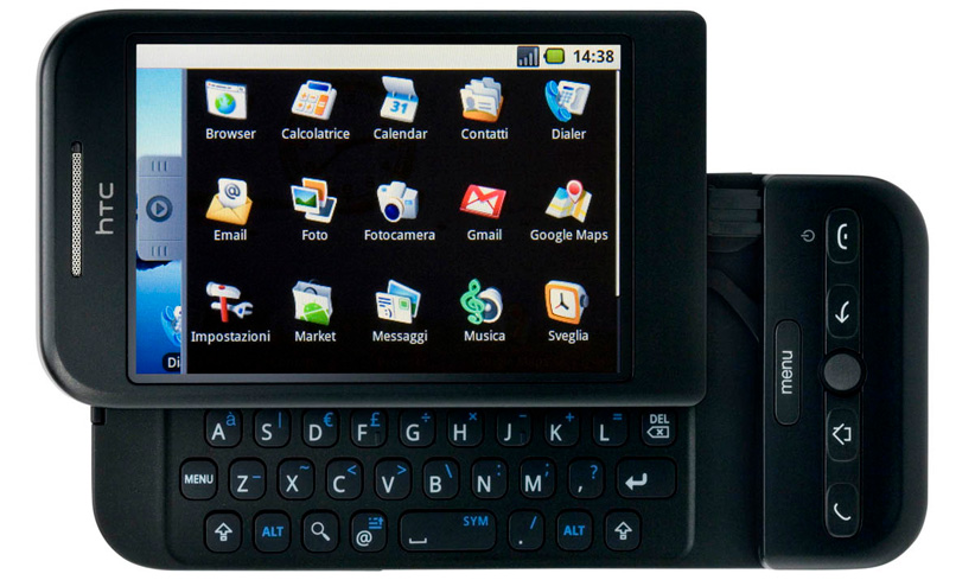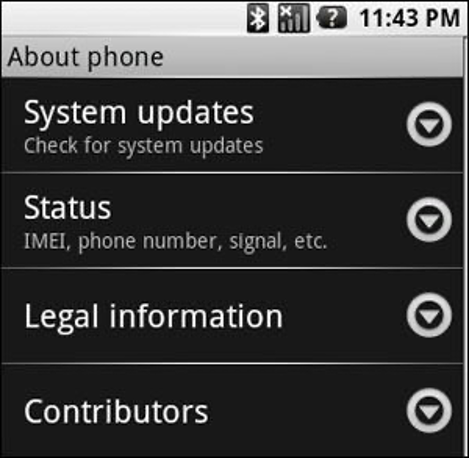The Android operating system has gone through several stages of growth and transformation in the years since its birth. Let’s start by looking at the Android development process. We have to admit that in the world of technology, no operating system or application software has experienced the rapid growth and development of Android, and Android has been at the center of this transformation, the fastest of all.
Finally, on September 23, 2008, Google released the first version of Android to pave the way for the release of various Android phones in the future. Perhaps the company’s executives at the time did not even imagine that one day this open-source product would become the most ubiquitous mobile operating system. In this article, we will have an almost detailed look at the development process of Android and we will describe the evolution of its capabilities from the first to the latest version.

When was Android found?
Android Inc. was founded in Palo Alto, California, in October 2003 by Andy Rubin, Rich Miner, Nick Sears, and Chris White. Though, the Android era officially began on October 22, 2008, with the launch of the T-Mobile G1 in the United States. In the beginning, this phone did not have many features that Android could not have imagined without it. For example, we can mention the lack of a virtual keyboard (touch), multi-touch capability, professional applications, etc., but this phone became the cornerstone for dealing with such an advanced Android today.

What are the previous Android versions?
In the following, we will briefly review the different versions of Android from the beginning to Android P (which was recently introduced):
Android operating system 1.0
Release Date: September 23, 2008
Android 1.0 was the first commercial version of Google’s mobile operating system to be launched in 2008 in the US and UK via T-Mobile G1. Also, this version of Android included YouTube applications, Gmail, Maps, Market and other applications such as Internet browser and calculator by default.
Other features:
- Ability to use multiple home screens (Home Screen)
- Ability to switch between applications (Task Switcher)
- Open the page using the template
- Ability to create folders and shortcuts on the home screen
- Limited camera settings and no video recording
- Lack of video player by default
- WebKit-based web browser with no multi-touch support for zooming
Android operating system 1.1
Release Date: February 9, 2009
Version 1.1 of the Android operating system was in fact a brief upgrade from the initial version, which was released at the same time as the global release of the T-Mobile G1 (sold under the HTC Dream brand in other markets). Google did not officially use dessert names for its mobile operating system at the time, but Android 1.1 was reportedly codenamed “Petit Four” or “sweeter” within the company.
Other features:
- Added the ability to view details and comments about different places in the Maps app
- Ability to attach files to messages
- Support for the “marquee” element in the browser for scrolling text
- Ability to use the dial screen while making a call

Android 1.5 OS – Cupcake
Release Date: April 27, 2009
“Cupkace” was the first version of the Android operating system to be officially introduced as a dessert; A tradition that Google still maintains and selects the title of each new version of Android in alphabetical order.
In Android 1.5, Google has improved its user interface with features such as automatic page rotation, page navigation with animation, and a new boot screen, and with the introduction of a virtual keyboard with word guessing, Android smartphones do not need a physical QWERTY keyboard.
It should be noted that Android introduced users to widgets (the point of difference between Android and iOS) for the first time in the cupcake version, and also added the ability to shoot videos in MPEG-4 and 3GP formats to the camera application.
Other features:
- Ability to copy-paste in the browser
- Ability to auto-sync Bluetooth and support A2DP
- Display the date and time on each call in the history
- Ability to select the desired photo for the audience
- Quick access to contacts via call history
- Ability to upload videos and photos directly to YouTube and Pica
Android 1.6 OS – Donut
Release Date: September 15, 2009
The Android operating system in version 1.6, nicknamed Donut, added support for WVGA screen resolution, which was compatible with many devices and was a significant improvement over the 320×480 resolution. It also made it possible to access the camera app at a higher speed and coordinate more with the gallery.
In addition to the above, the search section of the operating system was strengthened and in addition to the content on the device memory, it also searched for audio and text inputs in applications and the Internet. The market application was also upgraded and provided users with features such as software categorization based on the most popular free or paid items.
Other features:
- Ability to convert text to multilingual audio
- Ability to batch delete photos
- Update Support for CDMA / EVDO technologies, VIPs, 802.1x Wi-Fi and text-to-speech engine
- Increase search speed and camera app
- Wider framework of motor gestures
Android 2.0 – Eclair operating system
Release Date: October 26, 2009
The latest version of the Android operating system, introduced in 2009, was called “Eclair” or creamy pastry, and with a changed user interface and support for higher resolutions and live wallpapers, showed the entry of Android 2.0 series well. .
In this version of Android, features such as live navigation, voice guidance, traffic information, and 3D maps in the Google Maps app allowed smartphones to compete directly with car navigation devices. On the other hand, more camera features such as flash support, digital zoom, macro focus, color effects and light balance made users hesitant to buy digital cameras.
Of course, in early 2010, Google released an update called Android 2.1, which was with the same name as Eclair and only fixes some bugs. Along with this update, Google also unveiled its first Android smartphone with the Nexus brand (Google Nexus One), which was produced by HTC and was the first device to receive the next Android (2.2).
Other features:
- Support for syncing multiple accounts to email and contacts
- Support for Microsoft Exchange email service
- Bluetooth support version 2.1
- Quick Contact feature that shows an instant list of calls, text messages and other communication channels by touching the contact avatar
- Improved virtual keyboard typing speed, better word prediction performance and added audience names to predictable items
- New browser with HTML5 support, double-tap zoom and photo bookmarks
- MotionEvent technology for detecting and tracking multiple simultaneous touches
- Improved calendar
Android 2.2 operating system – Froyo
Release Date: May 20, 2010
Improving speed, memory and processing power were the most important slogans of Google at the time of the introduction of Android 2.2, nicknamed “Freud”. In this version of the Android operating system, using the “Dalvik JIT” compiler, the processing was done up to five times faster, and the 2 to 3 times improvement of Java, thanks to the use of the V8 version in the Android browser, along with the support of the Flash plugin. , Provided a good user experience of searching the Internet.
Voice command support was also significantly improved, making things like note-taking, routing, and searching possible. In terms of image quality, with the addition of support for Android 720p resolution, it took an effective step and increased the pixel density in 4-inch screens to 320ppi.
Other features:
- Improved Microsoft Exchange support
- Ability to create hotspots (Wi-Fi) and Internet sharing via USB cable
- New software store with the possibility of automatic and group updates of applications
- Fast switching between different languages on the keyboard
- Support for desktop and in-car Bluetooth dock
- GIF format support
- Ability to install software on external memory (App to SD)
- Combined password support
- Ability to view group photos in the gallery
Android 2.3 operating system – Gingerbread
Release Date: December 6, 2010
The most important development of the Android operating system in the gingerbread version was the improvement of processing efficiency along with better management of applications’ power consumption and simplification of the user interface, in addition to supporting higher resolutions for screens made manufacturers think of making bigger phones.
The addition of new programming interfaces (APIs) for game development also allowed game developers and independent developers to bring a richer gaming experience to the mobile platform. Google has finally added support for NFC, front-facing camera, and sensors such as barometers and accelerometers to take advantage of more powerful and complete hardware using its new operating system.
Other features:
- VoIP internet call support
- Optimal and fast keyboard with the ability to type speech directly
- Improved copy-paste capability
- New sound effects
- New and efficient download management program
- Supports WebM / VP8 videos and AAC audio format
- Ability to make voice and video calls via Google Talk
- Improve the performance of Gmail software and camera applications
- Improve battery performance
Android 3.0 operating system – Honeycomb
Release Date: February 22, 2011
“Honeycomb” was a special version of the Android operating system for tablets, which was launched to compete directly with the Apple iPad, and Google chose the Motorola Xoom tablet to be the first product equipped with Android 3.0 to demonstrate the capabilities of its new operating system.
The release of the Android in question seemed almost necessary at a time when +6-inch phablets were yet to be found, in order to improve the user experience of these products by optimizing the user interface for large tablet screens.
With Android Honeycomb, support for multi-core processors came to the world of tablets, and subsequent updates to this operating system also made it possible to connect peripherals such as mice and keyboards. The updates also included features such as resizing widgets and making apps compatible with higher resolution tablets.
Other features:
- Redesigned keyboard
- Easier copy-paste mechanism
- Improved browser and added new incognito mode
- Instant access to camera settings with new user interface
- Ability to encrypt all information on the device
- Support for FLAC audio codecs
- Support for joystick and gamepad
Android 4.0 operating system – Ice Cream Sandwich
Release Date: October 18, 2011
Version 4.0 of Android, nicknamed “Straw Ice Cream”, by combining the capabilities of Android 2.3 and 3.0 in one version and a new user interface, was able to integrate Android mobile and tablet. In this version of the Android operating system, support for the back, home and menu buttons came to the phones virtually (on the screen) for the first time, and the mechanism for creating folders with drag-and-drop mode (drag and drop) ) Improved.
One of the features of Android 4.0 was the ability to limit data consumption, which cut off the mobile Internet when it reached the limit. The “Android Beam” feature was also introduced in this version, which allowed devices with NFC chips to share information such as contacts or YouTube videos with each other.
The camera app was also improved, eliminating the gap between smartphones and digital cameras by eliminating shutter latency and adding modes such as panorama and time lapse. A default photo editing tool also made it possible to apply changes to images.
But perhaps one of the most interesting features of the Straw Ice Cream Android was the ability to use face recognition to unlock the phone, which it did through software and a selfie camera; A feature that Apple developed six years later with Face ID technology and special hardware.
Other features:
- Improved voicemail
- Ability to record screenshots by default
- Access apps via the lock screen
- Rebuilt People application with support for social networks and high quality photos
- Synchronize phone browser with PC Chrome bookmarks
- New gallery
- Wi-Fi DirecT
Android 4.1 operating system – Jelly Bean
Release Date: July 9, 2012
With the release of version 4.1 of the Android operating system (Geely Bailey), Google introduced the “Butter” project, which aims to provide a smooth user experience by using a stable page refresh rate of 60 frames per second, boosting CPU input and three-step buffer. It was a graphic output.
In this version of Android, the resident company of Mount View introduced for the first time the capabilities of a smart assistant in the form of aggregation of location information, favorite subjects and work schedule. Active notifications that touch the software environment were also introduced in this version.
Other features:
- Automatically resize shortcuts and widgets to accommodate new items
- Improved voice and motion control capabilities
- Bluetooth support for Android Beam alongside NFC
- Improved camera app with new user interface
- Supports 4K resolution
- New watch app
- Ability to use multiple accounts at the same time (tablets only)
Android 4.4 – KitKat
Release Date: October 31, 2013
Android KitKat took the use of Google Voice Assistant to a new level, and the phrase “OK Google” became the starting point for many English-speaking users of the operating system.
The new interface and the addition of the “Android Runtime” compiler instead of the old “Dalvik JIT” tool (not enabled by default) were the most important changes to the Android operating system in this version. Wearable came with it.
Other features:
- Optimized for use on weaker devices
- Ability to communicate wirelessly with printers
- Integration of sensor performance and pedometer capability

Android 5.0 – Lpllipop
Release Date: November 12, 2014
In Android Lollipop, Google unveiled a new user interface design called “Material Design” that displayed a more modern atmosphere with simple shapes, shadows and smooth animations.
In Android 5.0, it was possible to sync music, photos, contacts and other items among all the user’s Android devices, and for the first time, Google’s mobile operating system was introduced to smart TVs and cars.
Other features:
- Complete replacement of Dalvik compiler with Android Runtime (ART) and ahead-of-time (AOT)
- Support for 64-bit processors
- Rebuilt user bar and lock screen
- Volta project to improve battery life
- Ability to search device settings
- Ability to use multiple accounts for all devices at the same time
- “Tap and Go” feature to migrate to a new device using Bluetooth and NFC
- Ability to use the camera flash as a flashlight (by default)
- Smart lock
- New emojis
- Official support for multiple SIM cards in one device
- High quality voice call on 4G LTE platform through phones equipped with version 5.1 of Android
- Ability to make voice calls via Wi-Fi
Android 6.0 OS – Marshmallow
Release Date: October 5, 2015
Following the previous versions, Marshmallow Android 6.0 operating system again took steps to reduce battery consumption, and by providing “Doze” mode, the possibility of placing background applications in standby mode, as well as reducing the processor speed when the screen is off, Google’s emphasis Demonstrated energy savings.
On the other hand, the default support for fingerprint scanning technology and the possibility of restricting the permission of applications to access different parts (permissions) improved the security of Android version 6.0 compared to before.
Other features:
- Rename “Priority” mode to “Do Not Disturb”
- Application search bar
- Larger folders for apps
- USB-C support
- Ability to search for keywords within applications
- Supports 4K resolution for displaying applications
- Image feature in experimental image
- Ability to run the camera app by pressing the power button twice
Android 7.0 – Nougat operating system
Release Date: August 22, 2016
Android 7.0 Nougat added 72 new emojis to the existing ones due to the increasing trend of using emojis and provided users with a total of 1500 different emojis.
The user interface improvements continued in this version of the Android operating system, and the possibility of running two applications together was also provided by default. On the other hand, Vulkan programming interface was made available to developers to be able to produce higher quality 3D content in games and virtual reality.
Other features:
- Improved file management software
- More options in quick settings
- Picture-in-picture capability for Android TVs
- Battery increase warning
Android 8.0 – Oreo operating system
Release Date: August 21, 2017
The latest full version of Android, known as the “Orio” cream biscuit, along with user interface improvements, also introduced the “Android Instant Apps” feature, which allows users to download new applications without the need to install on the phone. Try online and web.
Also in Android 8.1, in addition to supporting the Unicode 10.0 standard, the cheeseburger emoji problem has been solved, and now in the Android cheeseburger emoji, cheese is on the burger; This issue has recently caused a lot of reactions from users.
In terms of performance, Google with the “Treble” project has made the biggest change to Android so far in the Orio version; A modular architecture that doubles the boot speed of the device and allows manufacturers to release updates to their products much faster.
Other features:
- Redesigned settings menu
- Simultaneous support for multiple monitors
- Downloadable fonts
- WiFi Assistant
- Detects the battery level of connected devices via Bluetooth
- Google Play “Protect” feature to combat malware
- Autofill forms seamlessly across all parts of the smartphone
- “Go” version available for devices with less than 1 GB of RAM
- Automatic change of light and dark themes
Android 9.0 operating system
Release date (beta version): May 8, 2018
Finally we have the latest version of the Android operating system! In this version, the official name of which has not been determined yet, we see more gesture support, and of course in Android P, the new procedure for manufacturers to use the screen cut is also considered, and this feature is defined by default for the latest version of Android. Has been.
Other features:
- New user interface for “quick settings” menu
- Move the clock to the left of the notification bar
- Added screenshot button to power settings
- New locking mechanism that, after activation, blocks the possibility of unlocking the phone by biometric methods (fingerprint, corneal scan, …)
- Use rounded corners in the interface
- Improved message notifications
- New animations when switching between apps
- Display battery level in always on display (AOD) mode
- Redesigned volume adjustment
- Experimental features include automatic Bluetooth activation while driving and a redesigned “About Device” screen












